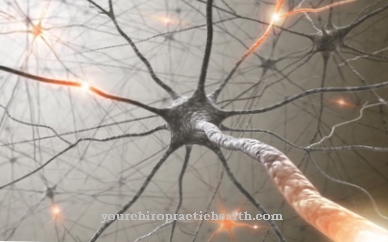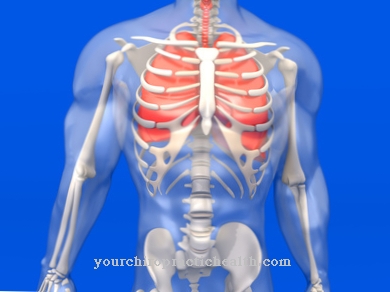Of the Lid closing reflex is a so-called polysynaptic external reflex, which serves to protect the eyes from the effects of foreign bodies and from dehydration. The reflex can be triggered by tactile, optical or acoustic stimuli, and fright can also activate the reflex. It always affects both eyes, even with tactile or optical stimuli that only occur in one eye.
What is the blink reflex?

The eyelid closing reflex, which serves to directly protect the eyes against the ingress of foreign bodies (e.g. insects or particles carried by the wind), is triggered by tactile stimuli on the cornea or the immediate vicinity of the eye. The reflex can also be activated by bright light stimuli. In this case it is mainly used to protect the retina and the photoreceptors (rods and cones) located in it against damage caused by excessive incidence of light.
When the reflex is triggered by acoustic stimuli, e.g. B.a loud bang or a frightful situation is a kind of prophylactic protection of the eyes. The involuntary, regularly recurring eyelid closure, which occurs without external stimulus and prevents the eyes from drying out, is also part of the reflex.
The eyelid-closing reflex is a so-called external reflex because it does not come from the organ that is affected, but because the organ that is acting is another. A nervous synaptic connection must be made in order to establish the connection between the affected organ and the active part of the body. External reflexes are therefore also referred to as polysynaptic reflexes. The disadvantage is that this makes the reflex much more cumbersome compared to a direct reflex that does not require any synaptic connections with the central nervous system.
The time from the tactile stimulus to the closing of the eyelid is around 250 milliseconds.
Function & task
The eyelid closing reflex fulfills important functions for mechanical protection of the eyes from the effects of foreign bodies and from sudden strong light that could damage the photoreceptors in the retina. In addition, the reflex in the form of the regularly recurring involuntary lid closure ensures the necessary tear film on the cornea, which closes the eye from the outside. The wetting of the cornea with tear fluid ensures that the eyeball can move smoothly in the truest sense of the word and that the incident light can pass through the rays clearly and thus for a clear and undistorted projection onto the retina.
The mechanical protective effect of the eyelid closure is supported by the so-called Bell phenomenon. Simultaneously with the closing of the eyelids, the eyes roll upwards and outwards completely unconsciously and unnoticed. As a result, the directly functional area of the eye, lens and pupil, is rotated out of the "danger area" and thus a further prophylactic protective effect is achieved. The eyes rotate into a position that they also assume during sleep.
In addition, the Westphal-Piltz phenomenon occurs during the reflexively triggered lid closure. Together with the lid closure and the Bell phenomenon, both pupils constrict. This phenomenon is also most likely used for prophylactic protection. The constricted pupils protect the photoreceptors from any strong flashes of light that may occur.
Since the blink reflex is an external reflex, the reflex can be conditioned to a certain extent or it can be weakened by prepulse inhibition. Only because of this is it possible to use contact lenses, for example. Contact lens wearers have to “train away” the eyelid closing reflex a little in order to be able to use contact lenses at all without triggering the reflex. The weakening of the reflex through prepulse inhibition means that the reflex is weakened overall by repeatedly touching the cornea, because the brain adjusts to further, stronger stimuli.
Illnesses & ailments
An impairment or failure of the eyelid closing reflex, including the repeated involuntary eyelid closing to wet the cornea, leads to problems with dry cornea, which are noticeable in itchy or burning eyes and in conjunctival irritation up to conjunctivitis. The risk of injury to the eyes increases because the protective reflex disappears or is greatly reduced.
Afferent sensory or efferent motor nerve fibers or the processing centers of sensory messages come into consideration as causes for the failure of the eyelid-closing reflex. Muscle paralysis (facial paralysis) of the facial muscles and especially the eyelid muscles can also lead to failure of the eyelid closing reflex.
Sensory tactile messages that can trigger the reflex run via an afferent branch of the 5th cranial nerve, the trigeminal nerve, to various nuclei before they are directed into the reflex center of the brain stem. In the event of a strong light stimulus, the stimuli are transmitted via the optic nerve.
The “instructions” for closing the eyelids run via the efferent branches of the 7th cranial nerve, the facial nerve, to the eyelid muscles. This means that the overall reflex is disturbed if only a single part of the reflex arc shows disturbances, as in an electrical series circuit.
Nervous diseases such as facial paralysis (facial paralysis) or paralytic lagophthalmos with paralysis of the eyelid muscles cause a partial or total failure of the eyelid closing reflex. The suppression of the reflex can also be caused by anesthetics. The effectiveness of local anesthesia around the eyes can be checked by provoking the reflex. If the reflex does not occur, local anesthesia is absolutely effective.
In the case of blind people, the eyelids usually close permanently. A permanent eyelid closure can also be provoked by certain irritants such as capsaicin. Capsaicin is the notorious substance found in peppers, which is notorious for its spiciness. The same or a similar active ingredient is also the main component of the notorious pepper sprays. When the active ingredient comes into contact with the eyes, the eyelid closes in a cramp-like manner, which lasts at least 30 to 40 minutes.



























